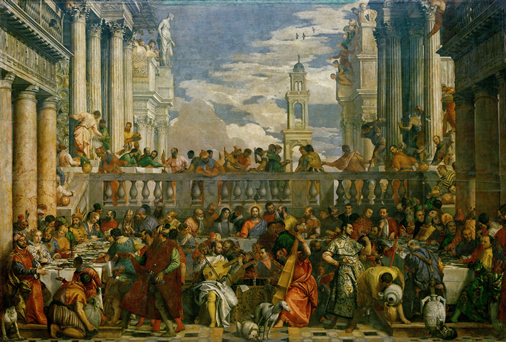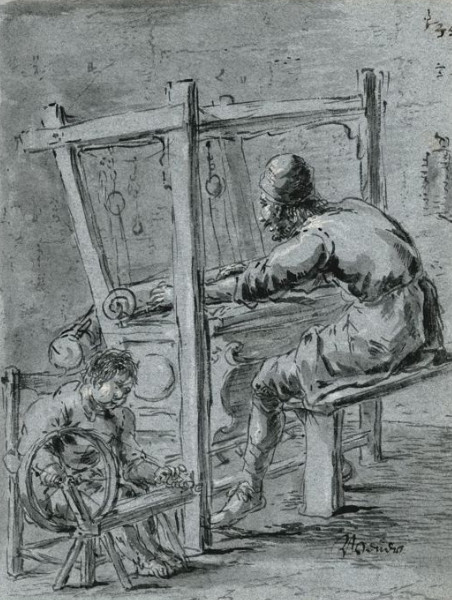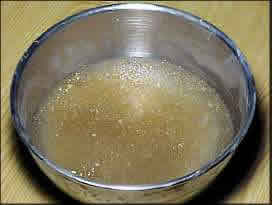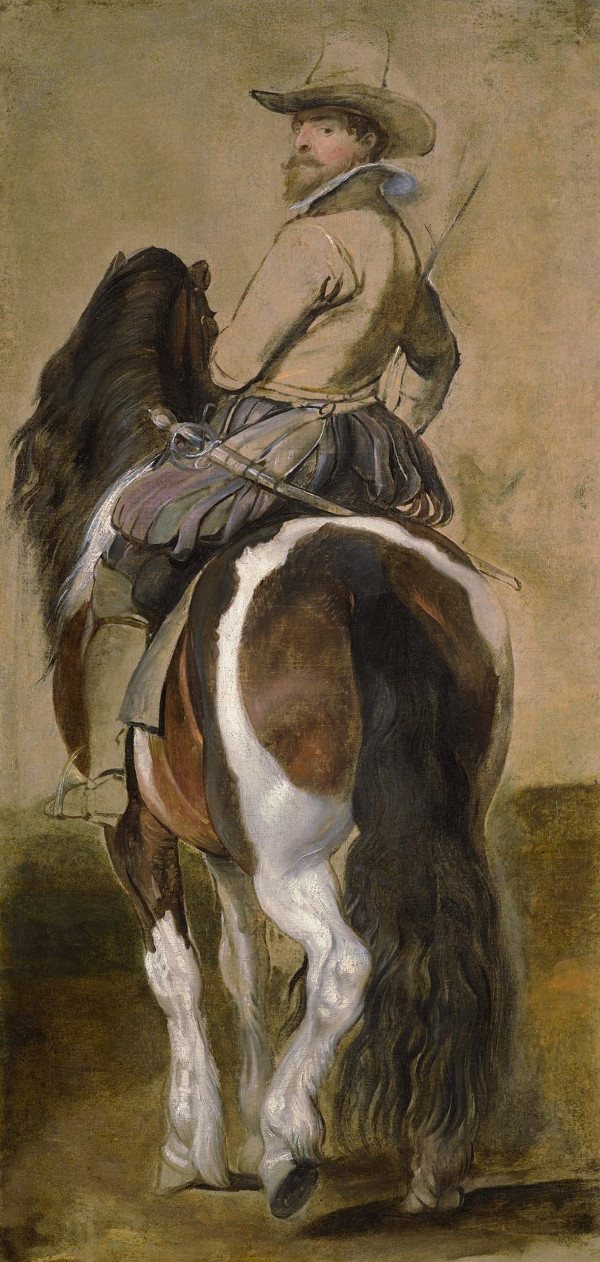Of the 35 or 36 surviving paintings by Vermeer, only two works, Girl with a Flute and Girl with a Red Hat, were not painted on canvas but on thin (oak?) panels. However, in the artist's death inventory of 1676 there were listed 10 unpainted canvases and 6 unpainted panels in his studio, indicating that the artist's preference for canvas was not as strong as the proportions of his surviving paintings would lead us to believe.
Canvas
In the seventeenth century, the production of linen canvas for painting was largely centered in Northern Europe, particularly in regions that are now part of Belgium, the Netherlands, and France. Flanders, a region that today is part of Belgium, was particularly renowned for its high-quality linen canvas. The city of Antwerp was a major center of both art production and canvas manufacturing during this period, and its products were exported throughout Europe.
Linen itself is made from the fibers of the flax plant, and the conditions in these Northern European regions were well-suited for flax cultivation. The manufacturing process was labor-intensive, involving the harvesting of flax plants, rotting the stems to remove the fibers, spinning, and finally, weaving. The resulting linen was then typically prepared for painting by applying a ground layer to create a smooth surface.
Given the high demand for canvas—not just for painting, but also for ship sails, tents, and other applications—the production of linen was a significant industry. However, it is worth noting that the production was not centralized; rather, it was often carried out by a network of small producers and workshops. This decentralized model allowed for a range of qualities and grades, which could cater to the varying needs of artists and other consumers.
Although canvas as a support for painting was known to the ancients, it became widely used in Italy for oil painting by the end of the fifteenth century. Until then, both tempera and oil painting had been done primarily on wood panels. The word canvas does not refer to any specific material in the field of textile fabrics, it applies to a number of closely woven materials of relatively coarse fibers. Linen is preferred for its superior strength. It is difficult to tear. It is also less hygroscopic than other fabrics that, instead, draw moisture from the air and release it upon drying. In this continual expansion and contraction the dry pigment cannot participate, which causes the paint to crack.
"Artist’s canvas, as such, was not manufactured in the sixteenth and seventeenth centuries. According to seventeenth-century Dutch sources, painters used several types of fabric, originally produced for other purposes. Zeildoek, also known as sailcloth or canevas, was produced for the shipbuilding industry, tijk, also known as ticking, was woven for mattresses and quilts, and lijnwaet, also known as linen cloth, was intended for clothing, bedding and the like. An English source speaks of sackcloth or sackencloth, apparently produced as packaging material. These types of canvas are made from two different kinds of fibers. Sailcloth was produced from hemp, ticking and cloth were made from flax. In research conducted on Dutch painter’s canvases over the past 60 years, the type of fiber has rarely been examined. This is not surprising because the canvases of sixteenth- and seventeenth-century paintings are usually not directly accessible since almost all canvases have been (re)lined."Michiel Franken, "3.1 Canvas as a Support," Counting Vermeer: RDK Studies, https://countingvermeer.rkdstudies.nl/3-sixty-years-of-thread-counting/31-canvas-as-a-support/. The width of a roll of cloth was limited by the width of the loom on which the linen was made.
Unless treated, canvas is very absorbent and quickly swallows up the oil content of the paint causing it to sink into the fabric. The final chromatic effect of the picture would be impossible to calculate and the roughness of the raw canvas world destroy any illusionistic effect. Canvas must first be properly stretched, sized and grounded before painting.

Paolo Veronese
1563
Oil on canvas, 666 x 990 cm.
Musée du Louvre, Paris
Canvas has various advantages over panel: it is easily transportable, it is far less laborious to prepare, and it can be used to make paintings of far greater dimensions. The Marriage of Cana (fig. 1), the largest known oil painting in the world, measures 66.6 x 9.9 meters (22 x 32 1/2 ft).
The tooth and spring of the prepared canvas facilitate a more rapid and expressive execution. It is also possible to effectively use greater quantities of paint and achieve more varied aesthetic solutions. At the same time canvas permits the painter to obtain fine detail, although not to the extent possible on a perfectly smooth panel. Various tones, degrees of roughness and absorption of the canvas can be achieved through different material choices and preparation methods.
The dimensions of canvases can be associated with local units of measure. The width of a roll of cloth was governed by the width of the loom (fig. 2). Most looms in Twente and Brabant, the main sources for canvas in the Northern Netherlands, were two ells (c. 138 cm.) wide, whereas widths of Italian canvases tend to range between 106 and 110 cm. Current research suggests that some seventeenth-century painters bought their canvases ready-made from specialized colormen.
Research on Vermeer’s canvases shows that the "painter purchased his canvases in small batches and used them over a short period of time. As we will see in chapter 6, among Vermeer's paintings, there are three groups of two paintings and one of four paintings where canvases originate from the same bolt. Vermeer provided a few paintings with a date, making it challenging to determine the exact creation dates of each painting" for better readability. Overall, the weave patterns suggest that the paintings were created in close chronological proximity. There is one exception within the group of four. While three paintings in this group seem to have been made between 1662 and 1664, one is usually dated several years later, in circa 1670-1671. As of now, there is no clear explanation for this discrepancy in time. The examination of canvases by other painters may help to find an explanation. It would be particularly enlightening to examine their canvases to see if there are canvases of these painters, which come from the same bolt as used in the paintings of Vermeer. This research should also include local primers, a nearly unexplored profession."Michiel Franken, "3.11 Weave matches," Counting Vermeer: RDK Studies, https://countingvermeer.rkdstudies.nl/3-sixty-years-of-thread-counting/311-weave-matches/#fn2.

Leonaert Bramer
c. 1650–1655
Prentenkabinet der Rijksuniversiteit Leiden, Leiden
Wood Panel
Before the widespread adoption of canvas, wood panels were the most common support for paintings. Oak was the primary type of wood used in the Netherlands for such panels. This was often imported from the Baltic regions due to the high-quality timber available there. Oak was preferred because of its durability and resistance to warping. The use of a single piece of wood was generally reserved for smaller paintings, while larger panels could be made up of several boards joined together. The thickness of these wooden panels could vary but was generally between 1 to 4 cm, depending on the size of the painting and the artist's intent. A thicker panel would provide more stability but would also be heavier, which could be a concern for larger works.
Wood panels offer a stable and rigid surface, making them less prone to the warping or stretching often associated with canvas. The mirror-like smoothness enables incredibly detailed and precise brushwork. However, the rigid surface of the wood panel makes impastoImpasto painting is a technique where paint is laid on the canvas or panel in very thick layers, often using a palette knife or a brush. The technique can create a textured, three-dimensional surface that adds depth and dimension to the work. Artists use impasto to capture the play of light and shadow on the textured surface, to lend intensity to colors, or to achieve specific artistic effects. In impasto, the paint stands up off the surface, and the strokes are often visible, providing a tactile quality that can evoke emotional or physical depth. This technique is commonly associated with oil paint due to its thick, malleable nature, but acrylics can also be used for impasto work. Artists like Vincent van Gogh, Rembrandt, and Jackson Pollock have used impasto techniques to great effect in their works. painting challenging. Thick paint is difficult to smooth out and manipulate on such a hard substrate If the painter's goal is to achieve precise definition of form and light, the paint must be applied relatively thinly, making the painting process more laborious. To acheive the maximum control and fine detail, paint was applied with the tip of the prush.
However, Vermeer employed wood panels for a different purpose. Due to their hardness, brushes laden with fluid paint glide more freely over wood panels than over canvas, which has a textured surface that creates drag and therefore more control. This characteristic gives the brushwork of Vermeer's panel works an unexpected, spontaneous quality, an effect the artist intentionally sought. Arthur K. Wheelock Jr. has hypothesized, that the hard, smooth surface of a wood panel gave Vermeer’s two panel paintings the sheen of an image projected by the camera obscura onto a plate of ground glass or tautly stretched oiled paper.
Of Vermeer's surviving works, only two paintings—Girl with a Flute and Girl with a Red Hat—are executed on wood panels. Both belong to the tronieThe term "tronie" is derived from the Dutch word "tronie," which is akin to the English word "face," or the French word "mug." Unlike a portrait that aims to accurately depict an individual, a tronie is more of a character study or a representation of a certain type or archetypal figure. Tronies often feature exotic or fanciful costumes, exaggerated expressions, or specific themes like old age, youth, or wisdom. In a tronie, the focus is not so much on capturing the likeness of a specific person as it is on exploring facial expressions, features, or character traits. The subjects can be imagined or generalized figures and may be intended to evoke particular moods or concepts. They allow the artist more freedom in terms of composition and technique compared to traditional portraiture. The genre was particularly popular among Dutch artists like Rembrandt. Four tronies by Vermeer have survived. Moreover, tronies were typically executed in smaller formats and were often produced for the open market, meaning they were not commissioned but rather sold to general consumers. Because of their generalized nature, they had a broader appeal than specific portraits and could be sold more easily. genre, a category that afforded artists considerable freedom to experiment with subject matter and technique. However, the prevalence of canvas in his known works may not accurately reflect Vermeer's actual usage of materials. Inventory records from two months after his death in 1675 reveal that six panels were stored in the upstairs front room of his house ("Op de voorkamer"), where he likely kept most of his art supplies.The inventory reads; "In the upstairs front room: Two Spanish chairs; A cane topped with an ivory knob; Two painter’s easels; Three palettes; 6 panels; Ten canvases; Three bundles of all manner of prints; A lectern; Otherwise here and there some clutter that does not merit individual mention." This suggests that wood panels may have played a more significant role in Vermeer's artistic practice than initially assumed.
Curiously, Girl with a Red Hat was painted on an already-used wood panel, which featured a loosely sketched portrait of a man wearing a large black hat. Instead of completely removing the unfinished painting, Vermeer chose to paint directly over it after rotating the panel 180 degrees. The reused panel was initially prepared according to standard Dutch painting practices. The unfinished portrit that served as the foundation for Vermeer's painting was prepared in the same way, using traditional Dutch ground layers: a lower layer of chalk was applied first, followed by a light-tan upper layer or primuersel.Alexandra Libby et al., "Experimentation and Innovation in Vermeer’s 'Girl with the Red Hat': New Findings from the National Gallery of Art," Journal of Historians of Netherlandish Art 14, no. 2 (Summer 2022): DOI: 10.5092/jhna.2022.14.2.2,
Format and Stretching
Musical Company (detail)
Jan Miense Molenaer
1631
Oil on canvas, 86 x 127 cm.
Staatliche Museen, Berlin
Vermeer's paintings are often similar in dimensions across different periods. This is unlikely to be coincidental and suggests Vermeer used standard sizes.Jørgen Wadum, with contributions by L. Struik van der Loeff and R. Hoppenbrouwers, Vermeer Illuminated: Conservation, Restoration and Research, 1994 (The Hague: V+K Publishing/Inmerc, 1994). The 1:1.4 width to height ratio he generally employed is very nearly square. The square format is the most visually reassuring and stable of all geometrical forms and has been widely used in the Netherlands although painters have generally avoided using the perfect square because it tends to have a stifling effect on the expressive content of an artistic composition.
"Another element of standard sizes for paintings is the different formats that were used for different subject matter. For example, seascapes generally had a height-to-width ratio of 1: 1.6, landscapes often had a ratio of 1:1.4, and portraits a width-to-height ratio of 1:1.2. Ten Vermeer's canvases have a width-to-height ratio of 1:1.2 or less than 1.2, indicating that the canvases were portrait format. Even those that appear to be in a landscape format have a height-to-width ratio of 1:1.2.
"On all of Vermeer's paintings that have tacking edges, the painted image is bounded on all sides by the fold line, which shows that the canvas was already mounted on a strainer at the time of painting as compared to the alternative practice of lacing the canvas onto a frame larger than itself. Several paintings show the ground layer extends beyond the painted image and therefore that the primed canvas was placed on a smaller strainer before painting, as mentioned above in connection with The Little Street and Lady Seated at the Virginal. The Milkmaid and Woman Holding a Balance are other examples of canvases where the ground covers the tacking edges completely. On most of the other paintings the ground covers only a part of the tacking edges. Three examples have been found so far where the ground does not extend at all onto the tacking edges. On the View of Delft, the tacking edges on all sides are very narrow; the canvas was stretched onto the largest possible strainer to make the maximum use of it."Gaskell, Ivan, and Michiel Jonker. Vermeer Studies ( Washington D.C.: National Gallery of Art; New Haven and London: Yale University, 1998), 147-149.
For centuries, wood has been the material of choice for the stretchers or strainers used to support the stretched canvases.
Vermeer generally attached his canvas directly onto the final stretcher, contrary to the practice of attaching it onto the oversize strainer. This latter method was a widely used and can often be observed in representations of painters in their studios (fig. 3). Although this method was employed principally for preparing the canvas, some painters even painted on the canvas while it remained on the strainer. The function of the oversize strainers must have been to provide a simple and effective way of stretching and restretching slackened canvases. The space between the threads holding the canvas, consolidated by the dry paint, resulted in the traditional scallop appearance of the canvas, exhibiting areas of extreme tension and some intermittent slack. Today's familiar expandable stretchers, which take up the lost tension by means of wedges inserted in the corners, became common only in the 1750s.
Uniquely among seventeenth-century canvases, Vermeer's Guitar Player, is still on its original strainer with the original wooden pegs used to fix the canvas.
Sizing

makes medium strength jelly.
Before applying the ground, canvases were first sized. Sizing effectively seals the canvas against the ground and paint layers, both of which contain drying oils that would be damaging if applied directly to the raw canvas. Sizing was made of clippings of rabbit hide, pig-skin or parchment which are sold in the form of thin brittle sheets or coarse crystallized grains. Size is first soaked in cold water (fig. 4), where it swells considerably. The size is then heated in a double boiler until it liquifies. Animal skin glue must never boil because it will crack shortly afterward.
The warm glue, about the consistency of honey, is spread on the canvas with a palette knife with quick, energetic strokes so it will penetrate and fill up the open pores of the canvas. Size was also employed as a binder for some pigments such as smalt. The presence of animal skin glue can be detected by laboratory analysis for its protein content.
Grounding
After the sized canvas is dry, the canvas is smoothed with a pumice stone before grounding. Grounding, or priming as it is also called today, provides the final surface suitable for painting. Grounding must produce a smooth surface that can be easily painted upon, it should be hard but not brittle (which causes cracking), and lastly, it should be porous enough to let the oil paint to adhere to the canvas.
The Dutch and Flemish often prepared their canvases with two layers of ground, called the Netherlandish double-ground. Generally, the first coating consisted of a mixture of earth pigments. At times, this layer may contain remnants from palette scrapings or the sediments from the jar of turpentine used to clean brushes. This produces a dirty grayish color, which may contain a large variety of pigments from the cleansing oil. Its purpose was simply to provide a smooth surface economically. The second ground layer, or imprimatura, usually consisted of a mixture of lead white and carbon black. In order to ensure optical neutrality, small amounts of iron oxide reds or other earth pigments were almost always added to the second coating, thus preventing the so-called "Rayleigh scattering," an optical effect which makes a light-toned gray over a darker color appear a harsh bluish gray. Evenly toned buff or light gray grounds can be observed in unfinished canvases, such a study by Peter Paul Rubens of a horse and rider (fig. 6), in which the flat brownish ground of the painting's background and parts of the figure's costume remained exposed to sight.

The ground material was spread with a sickle-shaped priming knife (fig. 5), such as the one illustrated in De Mayerne Manuscript, written by Théodore Turquet de Mayerne (1573–1655), a Swiss physician who lived most of his life in England. However, today, de Mayerne is noted for having authored one of the most comprehensive early modern treatises on painting and manuscript illumination techniques providing insights into the materials, tools, and techniques of artists of the time, making it an invaluable resource for historians and conservators.

Peter Paul Rubens
Oil on canvas, 118 x 56 cm.
Private collection
Though it is perfectly possible that Vermeer may have primed canvases himself, the ready availability of prepared canvases in seventeenth-century Netherlands, the lack of a large studio workshop and the conformity in size of clusters of his paintings indicate that he probably purchased pre-prepared canvases. A few canvases present a double ground which may suggest Vermeer’s desire to change the color of a pre-prepared canvas, this could have been done either by Vermeer himself or, equally likely, by the canvas supplier at Vermeer's request.
Vermeer generally used light grounds composed of chalk (an inert, inexpensive filler), linseed oil, white-lead and various combinations of earth pigments. For example, the ground of the Woman Holding a Balance contains chalk, white-lead, black and an earth pigment, most likely brown umber. The ground mixture was applied in one layer. The grounded canvas had a warm buff tone that can be seen in various areas of the painting where little or no paint was applied. It would seem that Vermeer prepared his canvas in the conventional manner. Although it's not out of the question, there is no evidence to suggest that Vermeer bought commercially prepared canvases.
Launched by Professor C. Richard Johnson Jr. in 2007, The Thread Count Automation Project,Margaret Holben Ellis and C. Richard Johnson Jr., "Computational Connoisseurship: Enhanced Examination Using Automated Image Analysis," https://people.ece.cornell.edu/johnson/ComputationalConnoisseurship.pdf. discovered striped patterns in color-coded images of local thread densities obtained from digital image processing of x-radiographs of Old Master paintings on canvas. These striped patterns provide a "fingerprint" or "weavemap," for pieces of canvas cut from the same roll. Such maps provide information about threads and weave patterns with such precision that scholars can compare the character of the canvas supports of different paintings. This knowledge can help determine, for example, whether canvas supports were made from the same bolt of cloth. As a consequence, weave maps are an extremely useful tool for assessing questions of dating, pendant relationships, and even authenticity. The system has shown that various canvases used by Vermeer belong to the same bolts of canvas. Canvas matches include:C. Richard Johnson, Jr., "6.1 Weave matches Weave matches," Counting Vermeer: RDK Studies, https://countingvermeer.rkdstudies.nl/6-exploiting-weave-maps/61-weave-matches/. The Lacemaker and Young Woman Seated at a Virginal; Young Woman Standing at a Virginal and Young Woman Seated at a Virginal; Woman with a Lute and Woman Writing a Letter, with Her Maid. More recently, the consideration of two Vermeer paintings, The Geographer and The Astronomer, proposed by Walter Liedtke and others as a pendant pair. Continuing examination of weave maps have revelaed the fifth match, Woman with a Pearl Necklace and Woman Holding a Balance, and sixth, Woman with a Lute and Woman with a Pearl Necklace.
The Value of Colored Grounds
Painters were aware that the color of the ground influences the perception of the tones and hues of the pigments which are applied to it, especially those used to render shadows, which were generally executed with thin layers of transparent paint. Dark toned canvases greatly aid the rendering of shadowed areas but require repeated layers of lighter paint to represent the strongly illuminated areas.
On the other hand, a very light ground will naturally show the light tones that painters often use in abundance. On a pure white ground any color is darker than the ground allowing the artist to paint in only one direction—from light to dark. Pure white canvas grounds were rarely used until Impressionism because it is very difficult to create harmony with strongly colored paints of such grounds. Moreover, on a white ground, tones must be applied more deliberately, a tinted ground acts as a middle tone, a sort of tonal safety net. For these reasons neutral or warm light grays were used by Vermeer as well as many other Dutch painters of the time, although he is known to have used a white ground once at the beginning of his career and a strongly reddish toned in The Love Letter.